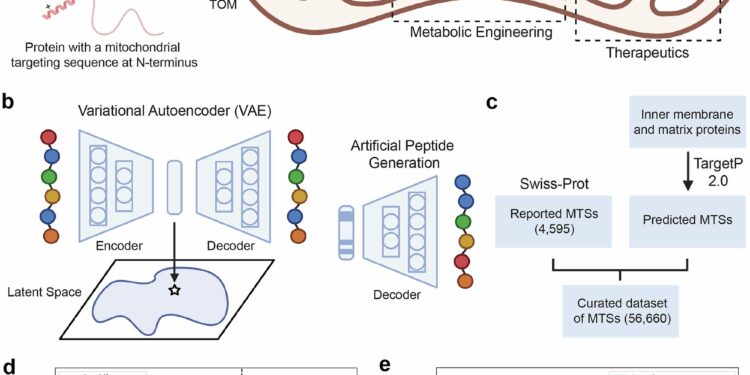Variational autoencoder for the generation of mitochondrial targeting sequences (MTS). Credit: Nature communications (2025). DOI: 10.1038 / S41467-025-59499-3
Mitochondria plays a critical role in cellular function, which makes it a primordial organal to target fundamental studies, metabolic engineering and therapies by the disease. With only a limited number of existing mitochondrial targeting sequences, a new study by the Carl R. Woese Institute for genomic biology demonstrates the usefulness of generative artificial intelligence to design news. The study is published in the journal Nature communications.
Just as each organ plays an important role in the human body – the heart of blood pumping or the lungs for breathing – the cells contain different compartments called organelles which contribute to the overall cellular function. These organelles have distinctive characteristics and environments to perform specific tasks for the cell.
Mitochondria is a specialized organization for energy production for cells, and its unique environment is also the ideal location for various cellular processes, including metabolic routes. Dysfunctional mitochondria have also been associated with aging and pathological states.
“Researchers want to study the biology of mitochondria which cannot be carried out effectively without using targeting sequences,” said Huimin Zhao (BSD / CABBI / CBD / MMG leader), the president of Steven L. Miller of the chemical and biomolecular engineering of the University of Illinois Urban-Champaign. “But we are currently limited by the availability of these mitochondrial targeting sequences, or MTSS.”
In order to maintain the organization and cellular processes, complex mechanisms are in place to ensure that protein cargo is delivered to the correct location. But rather than using an address and a stamp to send these packages through the cell, the proteins are labeled for delivery to a particular ordeal by unique amino acid targeting sequences.
The MTS found in the wild varies from 10 to 120 amino acids of length, on average of around 35 amino acids. Currently, only a handful of MTS have been identified and used, and there is a lack of predictable models in their sequences, which makes the design of new artificials difficult.
“There are only a few MTS that have been characterized, and people still use the same sequence,” said Aashutosh Boob, first author of the publication and former doctoral student of the Zhao group.
“One of the problems is that for different passenger proteins, there is a different optimal targeting sequence. Second, if the same sequences are often used, in particular in metabolic engineering, it can actually lead to a homologous recombination and then to genetic instability. So, ideally, there would be a library of various Mts by hand to test and use.”
The challenge is that the mitochondrial targeting capacities of an MTS arise from its chemical and structural characteristics in 3D space rather than its sequence of 2D amino acids. The generative AI can solve this problem by finding complex models in training data – in this case, MTSS found in nature – which are difficult to recognize and connect.
Using an unleuned in -depth learning framework called Variational Autoencoder, the research team identified the key characteristics of the MTS, in particular by being charged positively and amphiphilic and tendency to form a α propeller. They then designed a million MTS generated by AI and experimentally tested the mitochondrial targeting capacities of 41 of them. Using confocal microscopy for validation studies, they have reached a success rate of 50% to 100% in yeast, vegetable cells and mammal cells.
To further demonstrate the usefulness of the MTS generated by AI, the researchers applied targeting sequences for metabolic engineering and protein delivery – the latter which could be beneficial for therapy. They also illustrated how AI can help and understand the evolution of double targeting sequences for mitochondria and chloroplasts, highlighting the extent of scientific questions that could be studied using this technology.
Overall, this research marks an important step for the Zhao research group as the first generative publication of the AI of the laboratory. The study was particularly unique in the depth of the experimental work that was made to validate the results of the AI.
“The characterization of targeting sequences in the laboratory took us a long time, but we wanted to highlight their application, both in terms of metabolic engineering and therapy,” said Boob.
“This project lasted an important part of my doctorate, challenging myself to expand my expertise beyond the laboratory. This has strengthened my capacity to think critically and to design a rigorous scientific study, while giving me the chance to work with great people in a fun and fast environment that has made the experience both pleasant and reward.”
Zhao said: “AI is so hot at the moment, and people are really interested in knowing the potential AI applications, especially in the scientific field. This project clearly demonstrates that generative AI is a useful tool for synthetic biology and biotechnology.”
More information:
Aashutosh Girish Boob et al, design of various and functional mitochondrial targeting sequences through eukaryotic organisms using variational autoencoder, Nature communications (2025). DOI: 10.1038 / S41467-025-59499-3
Supplied by the University of Illinois in Urbana-Champaign
Quote: Generative AI exploitation to extend the Mitochondrial targeting tool box (2025, May 5) recovered on May 5, 2025 from
This document is subject to copyright. In addition to any fair program for private or research purposes, no part can be reproduced without written authorization. The content is provided only for information purposes.



